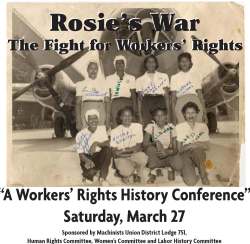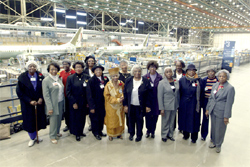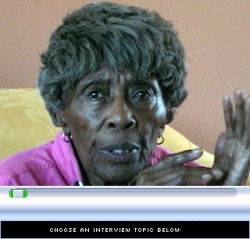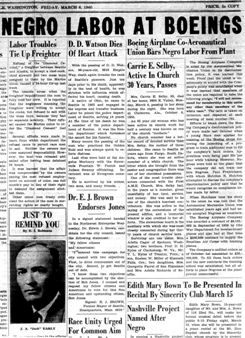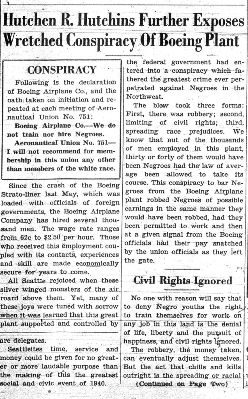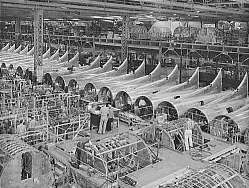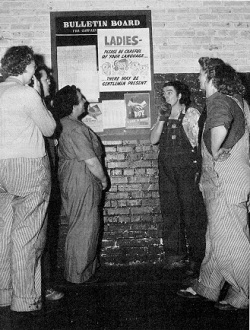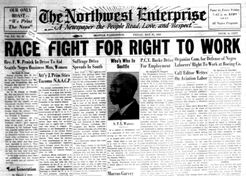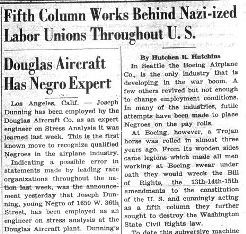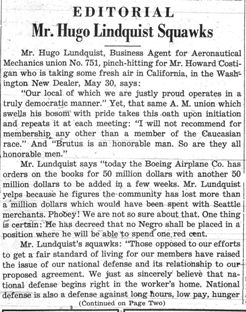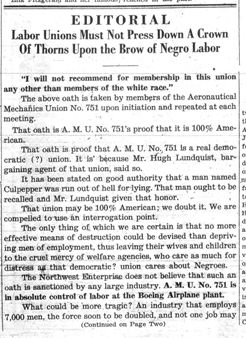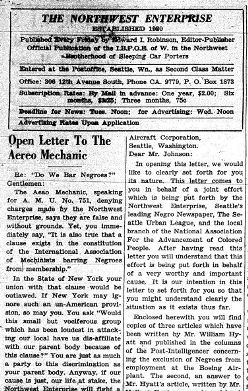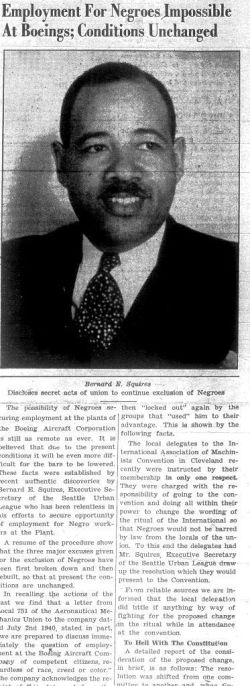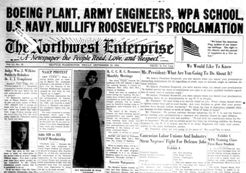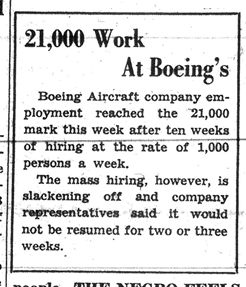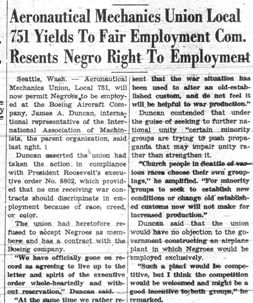In 1942, Florise Spearman and Dorothy West Williams became the first African Americans ever to be hired at the Seattle-based Boeing Airplane Company.1 This important milestone capped a long struggle for African Americans seeking the right to work at Boeing. Beginning in 1939 and continuing through World War II, African American activism combined with pressure from the federal government to finally force the company to relax its racially exclusive hiring policy and integrate its workforce.
This paper positions the campaign within the context of three overlapping developments. The first is the formation of a politically active African American community in Seattle over the course of the first four decades of the twentieth-century. Starting in 1939, a black activist and former local Communist Party leader, Hutchen R. Hutchins, led the charge against the Boeing Company and the International Association of Machinists. Hutchins founded the Committee for the Defense of Negro Labor’s Right to Work at the Boeing Airplane Company (CDNL) in 1940. The Seattle-based African American newspaper, the Northwest Enterprise, was the driving force behind this campaign, and Hutchins used his position as a reporter for the Enterprise to facilitate his activism.
The second context is the struggle between the Boeing Company and its principle union, the International Association of Machinists (IAM) Local 751. Boeing blamed Local 751 for the discriminatory hiring practices against African Americans while the local union in turn blamed both the company and its own national leadership. Briefly in 1940, the local union decided to allow African American members, but this was soon revoked when local union leadership was accused of Communist activities and removed by the parent IAM. In truth, both the IAM and the Boeing Company had histories of racial discrimination in the workplace. Boeing had never hired African Americans in its twenty-five years of existence, and the IAM had a clause in its oath that banned blacks from membership.
The third context is the role of the federal government. In June of 1941, President Franklin Roosevelt, under intense pressure from national African American leaders, issued Executive Order 8802. The order required that all companies with government contracts cease discriminatory hiring practices and established the Fair Employment Practices Committee (FEPC) to investigate the employment practices of companies like Boeing. However, despite the order, the Boeing Company did not immediately comply. As historian Quintard Taylor points out, “in the ten weeks after the executive order became law, the company hired 1,000 new employees per week, but not one was black.”2 And it would take even longer for the IAM to finally change its policy and grant African Americans membership.
BLACK SEATTLE
The United States entered the war in December of 1941 after the Japanese bombed Pearl Harbor. Men and women all over the nation joined the war effort by purchasing bonds, enlisting in the military, rationing food and supplies, and signing up to work in war craft industries. Many of these newer industries were located on the west coast, which prompted a large-scale migration of workers and their families to the region. As Taylor states, “forty-five thousand African Americans migrated to the Pacific Northwest to work in World War II defense industries.” Largely as a result, between 1940 and 1950 Seattle’s black population grew 413 percent, from 3,789 to 15,666.3
Despite their small numbers prior to World War II, African Americans in Seattle built an active community through networks of families, churches, civic organizations, and fraternal clubs.4 The first two African American churches, First African Methodist Episcopal, founded in 1886, and Mount Zion Baptist, founded in 1890, often opened up their facilities to the public for meetings, forums, and rallies.5 There were also black organizations such as the Knights of Pythias, the Masons, and the Odd Fellows.6 The community had a wide variety of nightclubs, entertainers, and sports teams that it supported.7 For its size, the African American community in Seattle was also very politically active. African Americans created a number of local branches of national organizations, including the NAACP, the Universal Negro Improvement Association, the National Urban League, and the National Negro Congress.8
Although Seattle seemed far removed from the Jim Crow South, with its brutal mobs and lynching, and even from the institutional racism of the Northeast, it was not free from the divisions caused by racial discrimination. Much like the rest of the nation, African Americans in Seattle were often the last to be hired and the first to be fired, and they were not admitted to most unions, including the longshoremen’s union and the waitresses’ union.9 This in turn often caused blacks to become strikebreakers, which further widened the gap between white and black workers in Seattle.10 African Americans were generally limited to menial jobs. Black men could work as servants, waiters, and janitors while black women most often worked as domestic or personal servants.11
Discrimination in Seattle was not limited to employment. African Americans were called racist names and segregated in schools. Segregated housing was another major concern as restrictive covenants banning blacks from certain neighborhoods became widespread during the interwar period. [link to “Segregated Seattle” section]. These covenants forced the majority of blacks to live in what is now known as the Central District, a region between Downtown Seattle and Lake Washington.12
African Americans generally stayed within the confines of their own community and, although politically active, did not often militantly challenge the discrimination that was evident in Seattle. There were of course exceptions. In the early 1930s, African Americans in the Communist Party, including Revels Cayton and the future chairman of the Committee for the Defense of Negro Labor’s Right to Work at the Boeing Airplane Company, Hutchen R. Hutchins, aggressively protested racism and discrimination in Seattle and linked it to events occurring in the rest of the nation. And in the mid thirties a broad coalition of black and white organizations, including the Communist Party, the NAACP, and the Urban League successfully fended off two anti-intermarriage bills introduced in the state legislature. More typically, however, small political groups would challenge discriminatory practices on a limited scale.13 For the most part, these efforts failed to yield dramatic results because the African American community was too small to make a major impact.
As the main newspaper serving the African American community in Seattle in the 1930s and 1940s, the Northwest Enterprise was the voice of a number of civil rights struggles. The newspaper’s editors were important political leaders in the African American community, including William Wilson who was president of the local chapter of the NAACP during the early 1930s, Prentice Frazier and Clarence Anderson who were leaders of the Seattle Urban League, and Edward Robinson who was a prominent business owner. The Northwest Enterprise gave each of these men a podium to voice their concerns over such topics as discrimination in the workplace and equal housing opportunities and helped bring the community together to achieve common goals. In the early 1940s, the paper would build on this legacy, becoming a crucial resource for black activists struggling for the right to work at Boeing.14
AFRICAN AMERICANS, ORGANIZED LABOR, BOEING, AND THE IAM
The Boeing campaign is also an example of how African Americans had to overcome conservative labor unions in their struggle for equal employment opportunities. Throughout the nineteenth and early twentieth centuries, unions often played a significant part in upholding the color line in American industries… The American Federation of Labor (AFL), founded in 1886 with Samuel Gompers as its president, was formed to help workers gain rights through solidarity and mutual aid.15 However, the AFL was not an organization intended for African Americans. Some AFL unions practiced discrimination in their ranks, even if they allowed African Americans to join, while others, like the IAM, explicitly barred African Americans from membership altogether.16
The International Association of Machinists was formed in 1888 and by 1889 had thirty-nine locals. In 1895, it joined the AFL, and over the next thirty-five years grew to be one of the largest unions in the Federation.17 The IAM was originally an organization for highly skilled craftsmen who performed general operations on locomotives and other engines. By the turn of the century this changed as groups of specialists such as the Allied Metal Mechanics entered the union. Over time, the jurisdiction of the IAM continued to broaden as semiskilled automobile and aircraft workers were admitted. By the 1930s, the IAM was no longer a union specifically for skilled machinists, but rather was beginning to resemble a quasi-industrial union.18
Discriminatory practices in the IAM started to change when the Congress of Industrial Organizations (CIO) challenged the AFL’s leadership. Led by United Mine Workers of America (UMWA) president John L. Lewis, a delegation to the 1935 national convention challenged AFL leadership by proposing a shift toward industrial unionism, a strategy that sought to organize both skilled and unskilled labor within entire industries. Lewis and his supporters were rejected by the AFL, which caused them to form the rival CIO.19 The CIO knew that it had to have an inclusive policy uniting black and white workers together if it was to gain power and survive in the labor arena. In 1939, the CIO had about 1,838,000 members and included The United Automobile Workers (UAW), the United Steel Workers (USW), the UMWA, the United Electrical Workers (UE), and the Amalgamated Clothing Workers of America (ACWA).20 In the late 1930s, these unions began to work with black communities, promising them more jobs and opportunities. Because of this, civil rights groups formed alliances with the CIO. As Walter White, the executive secretary of the NAACP, stated, “the CIO has proved … it stands for Negro advancement. It has fought for our people within the unions and outside the unions.”21
The Boeing Airplane Company became a battleground for the fight for African Americans’ right to work. Founded in 1917 by William Boeing, the Boeing Company started with just twenty-eight employees, including pilots, carpenters, boat builders, and seamstresses. After securing a Navy contract during World War I, Boeing was able to expand both in employment and in production. However, with the end of the war came a contraction in the demand for airplanes. The Boeing Company took to making furniture and boats in order to survive. Throughout the 1920s, Boeing was able to sell some small orders for aircraft, started to make mail-carrying planes, and even began to make passenger planes. By the 1930s, Boeing sent passenger airplanes from coast to coast, trained pilots, and continued to ship mail throughout the country.22
It was in the mid 1930s that Boeing started to build large military aircraft. The B-17 was developed in 1935 as the first Boeing military plane to have a flight deck instead of an open cockpit, and it was outfitted with bombs and machine guns.23 The Army Air Corps ordered eighty B-17s in 1940 and twenty more were sent to the British Royal Air Force that same year. The B-29 was introduced in 1939 and became the largest bomber to be manufactured during the war. It had a number of new special features, including mounted guns that could be fired via remote control.24 By the end of the war, 3,970 B-29s had been built, most of them at Boeing facilities.25 The massive contracts for both the B-17 and the B-29 enabled Boeing to come out of World War II as one of the nation’s leaders in airplane manufacturing and also one of the largest employers in Seattle.
The IAM established a local branch at Boeing in 1935 in order to unionize Boeing’s expanding number of workers.26 This branch, Local 751, was an industrial union, but it was assigned to the IAM by the Executive Council of the AFL. This occurred because although the AFL was generally against industrial unions, the international unions within the AFL were allowed to decide amongst themselves who was to have jurisdiction over what industry, and hence, what local. With only thirty-five founding members, IAM Local 751 was able to sign its first collective bargaining agreement with Boeing in 1936.27 The CIO was still very new and did not focus on the aircraft industry until 1939; by that time, the National Labor Relations Board (NLRB) recognized IAM Local 751 as the bargaining agent at Boeing and the workers there were well established with that union.28
In barring African American membership, the IAM was reinforcing the Boeing Company’s own longstanding policy of racial exclusion. From the company’s founding in 1917 through the first years of World War II, not a single African American was hired at Boeing, despite its massive growth over the period. Members of the African American community challenged the Boeing Company because it had become one of the largest employers in the region, and blacks wanted to be included. As Quintard Taylor writes, this meant that “if economic exclusion was at the heart of the black community’s dilemma, and progress in this area appeared virtually impossible, then politics and civil rights would provide a way out.”29 Drawing on existing community resources and a tradition of political activism, African Americans in Seattle would eventually gain the right to work at the Boeing Company, but it would take the intervention of the federal government for this to happen.
THE AFRICAN AMERICAN COMMUNITY DEMANDS EMPLOYMENT
African Americans first attempted to eliminate discrimination barriers at the Boeing Company in October of 1939. According to the Northwest Enterprise, “efforts to break down the Boeing Company’s discrimination policy were made last October 1939 when a young Race man applied for training at the Boeing shops following the launching of a program to train additional men to fill the company’s orders.”30 African American men applied for this training school knowing that, due to a large backorder, the company could use the extra labor. Still, the company made it clear that it did not hire African Americans.31 Boeing Company officials blamed IAM Local 751 for the discriminatory hiring practices, arguing that “Local 751 of the International Association of Machinists was the sole bargaining agent for the employees and as such, all hiring was done through the union.”32
The IAM had a clause in its oath which stated, “I will not recommend for membership in this union any other than members of the white race.” This oath was repeated before every Local meeting.33 The Northwest Enterprise began publishing a series of articles condemning both the Boeing Company and Local 751 once it learned that both groups used this oath as an excuse for not hiring blacks. This jumpstarted efforts to have the clause removed from the oath.
In May of 1940, African American activists in Seattle came together to form the Committee for the Defense of Negro Labor’s Right to Work at Boeing Airplane Company (CDNL). The CDNL was supported by a number of groups, including churches, clubs, and other community organizations, in an effort to get African Americans hired at Boeing. Black men were encouraged to apply for jobs at Boeing and were told, “Do not take NO for an answer. If you are refused, learn why and who refused you.”34 The CDNL built a strong case against both the company and the union, demanding an amendment to the union oath, admission of African Americans into the union, and the removal from office of anyone who continued to defend racial exclusion.35
Hutchen R. Hutchins, a longtime black activist who was then working as a reporter for the Northwest Enterprise, was appointed as the chair of the CDNL when it formed in 1940. Hutchins originally came to Seattle in 1932 as a district leader for the Communist party (CP), and was one of a number of African American Communists in the area. After being forced out of the local CP leadership in 1933, Hutchins’ remained involved in left labor politics as the president of Seattle’s Negro Workers Council.
Hutchins’ Communist affiliations point out the important role the CP played in local civil rights struggles during the 1930s, especially in the labor arena. Revels Cayton was another prominent African American Communist who formally joined the Northwest Party in 1934 after being actively involved in Party activities for several years. Cayton was drawn to the CP because of its activist ideals and its willingness to openly attack racism and discrimination, and was able to quickly work his way up through the ranks to become one of the few African American leaders in the party. Cayton used communism to push his own civil rights agenda, staging protests to draw attention to the discrimination found in labor unions and segregated local businesses.36 Susie Revels Cayton, Revels’ mother, also became a member of the Communist party, in large part due to its civil rights stance. She saw how her son was becoming empowered through the CP and sought to use it to her advantage as well.37 For local African Americans like the Caytons and Hutchen Hutchins, as well as for African Americans in other regions of the country, the Communist party in the 1930s was an important ally in the struggle for civil rights and social justice. However, association with the CP also left black and white activists open to the red baiting tactics of civil rights opponents who sought to paint the movement as subversive in order to discredit it. Communists within the IAM would face this challenge in the early 1940s at the Boeing plant.
By 1939 it is unclear whether or not Hutchins was still a formal member of the Communist party. However, his continuing ideological commitment to the Party is apparent in the fact that his reporting for the Norwest Enterprise had a distinct communist flavor. For instance, in an article headlined, “Fifth Column Works Behind Nazi-ized Labor Unions Throughout U.S,” he wrote:
If the leaders of Boeing Aeronautical Union No. 751 would have ignored this feudal oath and admitted Negroes, the International would have said nothing. Had it done so, the union leaders would have become a model of courage and progress and labor history would point to its leaders with pride. The same machine is trying to defend the jim-crow position of the union and place the blame on the American Federation of Labor. While the A.F.L. certainly needs an immersion, it does not lessen the guilt of Mr. Lundquist [Hugo Lundquist, business agent for the Aeronautical Machinists Local 751] and others … The most dangerous enemy facing Negroes here is jim-crowism and segregation masquerading under the banner of liberalism and progressivism in labor unions.38
Hutchins and other African American community leaders in Seattle were trying to show that discrimination existed in Seattle, and that it was unjust to ban African Americans and other minorities from positions in Local 751 at the Boeing Company. They blamed Hugo Lundquist for the refusal of the local to hire African Americans, stating in the Northwest Enterprise, “he [Lundquist] has decreed that no Negro shall be placed in a position where he will be able to spend one red cent.”39
In response to attacks from the Northwest Enterprise, Local 751’s newspaper, The Aero Mechanic, published an article titled, “Do We Bar Negroes?” in order to address its position on the matter:
Attacks have been recently leveled at Local No. 751 – unfair and unjust attacks on the charge that we, as an organization, are opposed to the hiring of Negroes by Boeing. We wish to state clearly and emphatically that such charges are entirely false and without grounds. It is true that the Boeing Company does not hire Negroes. But since when has Local 751 had any control over the company’s policy in this connection? It is also true that a clause exists in the constitution of the International Association of Machinists barring Negroes from membership. Would this small but vociferous group which has been loudest in attacking our local have us dis-affiliate with our parent body because of this clause? For their information, it has been progressive locals like our own that for years have been fighting at the International Conventions of the I.A.M. for the elimination of this clause. It is to be hoped that we may be more successful at the forthcoming convention. Certainly, of all the trade unions in the city, we feel that the direct attacks against us as proponents of racial discrimination prejudice or chauvinism, is not only unfair and unjust, but is inspired by certain anti-labor elements to disrupt our union while it is in the midst of serious negotiations with the company. To the honest and sincere colored workers in Seattle – and there are many of them – we can state that a committee … has been set up to try and find a solution to what we recognize as an important issue.40
This article was reprinted in the Northwest Enterprise on July 12, 1940. The African American community viewed Local 751’s response with hopeful but still skeptical eyes. The union refused to take responsibility for the demands of the black community and instead came up with excuses that needed to be challenged.
LOCAL 751 AND THE AFRICAN AMERICAN COMMUNITY NEGOTIATE
Negotiations opened up between IAM Local 751 and representatives from the CDNL in July 1940. Bernard E. Squires, Executive Secretary of the Seattle Urban League, was chosen to present the demands of the African American community to the Executive Board of Local 751.41 The two groups deliberated over the issue of the union’s oath as well as concerns that “Negroes might prove to be potential strike breakers and scabs.” It was successfully determined that “the Negro is not a potential strike breaker but has proven to be the backbone of many important strikes in the Northwest.” 42
Union members promised to open the union to African Americans, and Local 751 president Barney Bader and business agent Hugo Lundquist were asked to call for the removal of the membership ban at the International Convention of the IAM.43 The two groups finally decided that Local 751 would bring these grievances to the International Convention, with Squires giving the report at the international meeting in Cleveland, Ohio that September. They agreed to join forces in order to “wipe out forever the exclusion clauses now existing in the ritual constitution of the International Association of Machinists.”44
The Boeing Company blamed the union for barring blacks from working at the company. As it stated, “the Company has an agreement with the Aeronautical Mechanics Union, Local No. 751 which provides that all employees working under the agreement shall become members of the Union.”45 This meant that the Boeing Company shifted the blame for discrimination from itself onto the IAM. However, Boeing had been in operation for more than twenty years and had only dealt with the union since 1935. During those twenty years, African Americans were never hired. This clearly shows that the company was also guilty of racial discrimination.46
At the international IAM meeting in Cleveland, Squires discovered that Local 751 was not sincere in its commitment to end discrimination and include African Americans in its membership. His attempts to persuade the IAM to remove the discriminatory clause from its constitution proved fruitless. What was most disheartening was that “the local delegation did little if anything by way of fighting for the proposed change in the ritual while in attendance at the convention,” which meant that Squires did not go to the convention with the support he assumed he had.47
LOCAL 751 SHAKE UP
Throughout the 1930s, the Communist party in Seattle had supported the inclusion of African Americans in organized labor. Although the IAM was affiliated with the more conservative AFL, Communists and other leftists maintained an active presence within the union. Ironically, this fact kept the rival CIO at bay. In his autobiography, local CP leader and CIO organizer Eugene Dennett mentions that “the Seattle “left” in the CIO was on good terms locally with the AFL Machinists, so we felt it was unwise to interject contention from a far-away source.”48 That Communists in the CIO felt it unwise to intervene in a segregated union perhaps indicates that by 1940, CP support for African Americans had waned.
In 1940, in the midst of the CDNL’s campaign to integrate Boeing’s workforce, an internal struggle within Local 751 brought charges of communism against certain members of the union and led to the restructuring of Local 751. IAM President Harvey Brown personally went to Seattle in April of 1941 to sort out the matter. Brown revoked the local charter and all of the union leaders accused of communism were expelled from the international union. In response to the leftist views held by some of the union members, Brown stated:
“Subversive forces are deceptively working to obstruct the National Defense Program. Recently, there was plotted a program to cause a stoppage of work, to bring idleness to all employees of the Boeing Aircraft Company. The time has come for you to call a halt. Developments demand that every loyal member, worthy of our American institutions, cooperate to the utmost in cleansing Lodge No. 751 of the Communist element now gnawing at its vitals.”49
A few days later, he wrote again:
“Aeronautical Mechanics Lodge 751 has been a long suffering victim of Communist strategy, character assassins, deliberate lying; in fact, perjury to create confusion, prejudice, hate, bitter feeling among members.”50
The return of the delegates from the IAM convention in Cleveland also sparked dissension within Local 751 when one faction of the Union leadership was accused of Communist activities. Among those accused were Bader and Lundquist, who were singled out in an editorial published in The Aero Mechanic.51 The parent IAM swept in and removed the accused Local 751 leaders and installed new leaders who were more in tune with the policies and practices of the national IAM leadership. Those removed were thought to have CIO leanings.52 Significantly, the Executive Board also decided to retract the agreement that included African Americans in the union. All local leaders who had supported the removal of the clause prohibiting black union members were accused of being Communists and were removed from their positions.53 Thus, the shakeup within the IAM leadership is an example of how red baiting was sometimes used as a tool to obstruct civil rights activism.
EXECUTIVE ORDER 8802 AND THE FEPC
President Franklin D. Roosevelt issued Executive Order 8802 on June 25, 1941.54 The order provided the federal backing needed to finally push through integration at Boeing, but not without continued pressure from civil rights activists. Ten weeks later the Boeing Company had hired about 10,000 new employees, but none of them were African American.55 Noting the company’s lack of progress, the Northwest Enterprise stated, “The president’s memorandum issued to quiet the rising tide of Negroes’ protest against the hypocritical stand of industry and labor denying the Negroes’ right to work in plants holding contracts for national defense falls on deaf ears in the far northwest.”56 In September of 1941, a full two months into Executive Order 8802, a young African American man named Eugene Beech was denied entry into the Aircraft Defense Training School, which was a requirement for anyone working at the Boeing Company. Beech was sent home after only two days in class because instructors thought that, due to his race, he would not be hired at the Boeing Company even after full training. “I remember Eugene Beech,” his instructor said, “and thought he was a very likely young man … but there is nothing we can do. I think it grossly unfair to let a person complete the course with the expectation of getting a job when we know he cannot.”57 Washington’s U.S. Senator Monrad C. Wallgren and Congressman Warren G. Magnuson were asked to look into the Beech case and the issue of discrimination at Boeing.58 Both men agreed that the case against Beech was unacceptable, and Senator Wallgren sent it on to the Office of Production Management, which was in charge of the Fair Employment Practices Committee.59 Ultimately, the ban against Beech was lifted; the Office of Production Management announced, “it will ‘do everything possible to remove bans against qualified negroes in both training and employment.’”60
That same September, the NAACP filed a complaint with the FEPC. By April 1942, the FEPC helped to insure that Local 751 issued work permits to African Americans. The Local complied only grudgingly, stating, “we [Local 751] have officially gone on record as agreeing to live up to the letter and spirit of the executive order whole-heartedly and without reservation … at the same time we rather resent that the war situation has been used to alter an old-established custom, and do not feel it will be helpful to war production.”61 Despite IAM compliance, problems persisted. A handful of African American women were hired at Boeing, but were not allowed membership in the union. They were required to purchase temporary permits at a cost $3.50 per month, which was more than monthly union dues. The Northwest Enterprise expressed outrage over this thinly veiled attempt to circumvent the executive order:
First of all it means no security of job or certainty of relief. That being the last to be hired, we’ll surely be the first to be fired. That because we are Negroes, we must remain on the narrow ridge of economic survival, only partially connected with our nation’s remedies, but dumb victims of its difficulties. It means that in spite of our President’s executive order of no discrimination in defense industry, that this union will continue to discriminate even though it be at the cost of unity and morale, factors definitely essential to winning the war.62
Seattle’s African American community played a crucial part in forcing Boeing to hire black workers, but it was the FEPC that obligated Boeing to finally hire its first black workers. Even then, it would take more time and pressure for African Americans to gain unrestricted access to employment at Boeing and membership in Local 751 of the IAM.
WORKING AT BOEING
Over time, it became increasingly clear to the Boeing Company that qualified African Americans were going to continue to apply for jobs and that the company would be legally obligated to hire them. With the wartime industry boom, a number of African Americans came to Seattle to work at Boeing. As was the case in defense industries throughout the nation, many of these workers were women. They had been trained in their local areas by the National Youth Administration, which was created during the 1930s as a way to train young people in trades and then assist them in finding jobs.63 Once they came to Seattle, many found work at Boeing, although they were still subjected to racial discrimination. Some of the African American women who worked at Boeing during World War II recall their experiences as positive, as they were able to travel away from home, seek adventure, and make more money than they ever had before. However, others remember the discrimination faced in the workplace as they were banned from the union and treated like second-class citizens. Whatever their experience, these women owed their jobs to the activism of the local African American community and the intervention of the federal government.
Belle Alexander described how in Georgia she was trained in sheet metal for three months, welding for another three months, and then was put on a bus bound for Seattle. She remembers working with mostly women in the three years she was at Boeing. As a sheet metal worker, Alexander felt that “They don’t talk about nothing but the Riveter,” and wishes other skills were highlighted in the history books as well. A variety of skills were needed to properly build and assemble airplanes at that time. Alexander compared it to making a cake. As with a cake, workers had to start from scratch, from the making of each panel to the assembly. Working for sixty-two cents an hour, Alexander paid union dues but was not allowed to join Local 751. After working at Boeing for three years, she left to start a family, and did not go back because, in her words, “By the time I was all ready to go back, Japan had surrendered.”64 There was little job security for African Americans who worked at Boeing during this time, although to some degree this was true across racial lines as whites were also laid off in significant numbers after the war.
Other women had similar experiences. Katherine Thompkins came to Seattle from Tulsa, OK when she was sixteen years old. She had trained in welding, but, “When we got out here, the welding we couldn’t do, because of our race.”65 Her instructor had told her of the possibility of racial discrimination in the workplace, but until she arrived it was unclear what she would have to face. The Boeing Company retrained her in sheet metal work. Thompkins first worked at Plant 1, known as the Little Red Barn, as a mechanic. She too recalls working for sixty-two cents per hour, and received a substantial amount of overtime. Through this she was able to earn a great deal of money. At the end of the war, she was laid off for nine months because her plant was shut down. When the plant reopened, Thompkins was rehired. Although Local 751 did not allow her to join when she first started working at Boeing, she recalls that by 1948 everyone was admitted to the union. Thompkins worked for the Boeing Company for almost forty years. Reflecting on that time, she says, “I felt that it was a difficult job, but the best job for a woman,” because she was able to make more money, have more opportunities, and receive better benefits.66 Although she was thankful for the job at Boeing, Thompkins remembers facing discrimination in Seattle. For instance, she was not allowed in some shops or restaurants because of her race. There were no signs on these establishments, but she could tell by the atmosphere that she was not welcome. Some restaurants refused to serve her outright. Summarizing her experiences from that time, Thompkins reminds people that “we still have discrimination now;” it has not gone anywhere.67
Katie Burks and Vivian Laye both came from Birmingham, Alabama to work at the Boeing Company. Burks first worked in the tool room and then later as a mechanic. She recalls that coworkers would offer her candy and food stamps if she would do their work, which she gladly did. She also felt a sense of confidence in herself and her job. As she stated, “if the supervisor said anything to me that I didn’t like, I’d tell him off.”68 . Vivian Laye weighed only 92 pounds when she first started working for the Boeing Company, and the first machine she was assigned to was too heavy for her to operate. Both women worked on the B-17 and the B-29.69 The confidence that Burks recalls may have stemmed from the fact that the black community she moved into was small, and most of the blacks she interacted with were not native to Seattle. Even her church, People’s Institutional Baptist Church, had a congregation mostly made up of African Americans from out of state. Laye, however, remembered discrimination in Seattle: “we felt it [discrimination] was more here, because it was hidden.”70
These women all came to Seattle to work at the Boeing Company during World War II, either to move away from home, to seek adventure, or to support the war effort. They shared similar experiences but different perspectives, which varied from resentment toward the Seattle community and the discrimination faced there, to a sense of belonging and freedom from racial discrimination.
CONCLUSION
In 1944, Boeing employed a wartime peak of 1,600 black workers. In 1945, the leadership of Local 751 decided to once again pressure the IAM to remove the clause in its constitution barring African Americans from membership. Local 751 brought the largest delegation of any IAM local to the International Convention in New York. It challenged the discriminatory clause, but was outvoted. A year later, the delegation tried again and this time, was successful. In 1946, Local 751’s delegation convinced the IAM to remove the discriminatory clause from its ritual oath.71
African Americans finally won the right to work at the Boeing Company and to participate in Local 751 after a long ordeal involving both a grassroots community campaign and government intervention. Without the efforts of local black activists, the Boeing Company would have continued to deny employment to qualified African Americans. Ultimately, it was FEPC that forced the integration of the Boeing Company, but it was the Seattle African American community, led by the Northwest Enterprise and the CDNL, which had to bring the issue to the attention of the federal government in order to correct the problem. However, even after Boeing began hiring African Americans, blacks still faced racial discrimination in the workplace. There were segregated lunchrooms and bathrooms, and white workers had nicer facilities than black workers. African American workers were often denied promotions and were laid off for protesting discrimination.72 And of course being hired did not ensure fair treatment, or even admittance until 1946, in the union. Today, Boeing has come a long way to become a highly integrated workforce with a strong anti-discrimination policy. However, discrimination still exists; it is important to remember how and why people fought discrimination in the past in order to not just keep the status-quo, but to continue forward in the fight for equality in the workplace, on the street, and in the home.
Copyright © Sarah (Miner) Davenport 2006
HSTAA 498 Autumn 2005; HSTAA 499 Spring 2006
1 Quintard Taylor, The Forging of a Black Community: Seattle’s Central District from 1870 through the Civil Rights Era (USA: University of Washington Press, 1994), 163-165.
2 Ibid, 163
3 Ibid, 159
4 Taylor, Forging, 136.
5 Ibid, 138
6 Ibid, 139
7 Ibid, 147,153
8 Ibid, 87-88
9 Ibid, 55-57
10 Ibid, 58
11 Ibid, 61
12 Ibid, 80-82
13 Ibid, 89, 94
14 Gerald J. Baldasty and Mark E. LaPointe, “The Press and the African-American Community: The Role of the Northwest Enterprise in the 1930s,” Pacific Northwest Quarterly Winter 2002⁄2003: 14-26
15 “AFL-CIO,” History, Samuel Gompers (1850-1924), (2006) http://www.aflcio.org/aboutus/history/history/gompers.cfm.
16 Bruce Nelson, Divided We Stand. American Workers and the Struggle for Black Equality (Princeton: Princeton University Press, 2001), xxxi.
17 “IAM Headquarters” History of the IAM (2006) http://www.goiam.org/content.cfm?cID=868.
18 Walter Galenson The CIO Challenge to the AFL. A History of the American Labor Movement 1935-1941 (Cambridge: Harvard University Press, 1960), 495-496
19 “AFL-CIO,” History, John L. Lewis (1880-1969), (2006) http://www.aflcio.org/aboutus/history/history/lewis.cfm.
20 John McCann, Blood in the Water: A History of District Lodge 751, International Association of Machinists and Aerospace Workers(Seattle: District Lodge 751, IAM&AW, 1989), 9-10
21 Nelson, Divided We Stand, xxxii
22 “Boeing” History, The Shared Heritage (2006) http://www.boeing.com/history/narrative/n001intro.html
23 “Boeing” History, B-17 Flying Fortress (2006) http://www.boeing.com/history/boeing/b17.html
24 “Boeing” History, B-29 Superfortress (2006) http://www.boeing.com/history/boeing/b29.html.
25 “Boeing” History, The Shared Heritage
26 McCann, Blood in the Water, xvi
27 Taylor, Forging, 163
28 McCann, Blood in the Water, 23-24
29 Taylor, Forging, 78
30“Boeing Airplane Co – Aeronautical Union Bars Negro Labor From Plant,” Northwest Enterprise, 8 Mar. 1940: 1
31 Ibid
32 Robert Bedford Pitts, Organized Labor and the Negro in Seattle(Seattle: University of Washington, 1941), 74
33 “Hutchin R. Hutchins Further Exposes Wretched Conspiracy Of Boeing Plant,” Northwest Enterprise 5 Apr. 1940: 1
34 “Organize Com. For Defense of Negro Laborers’ Right To Work at Boeing Co.,” Northwest Enterprise 31 May 1940: 1
35 Hutchin R. Hutchins, “Fifth Column Works Behind Nazi-ized Labor Unions Throughout U.S.,” Northwest Enterprise 7 Jun. 1940: 1-2
36 Sarah Falconer “Revels Cayton: African American Communist and Labor Activist” Seattle Civil Rights and Labor History Project(2005) revels_cayton.htm.
37Michelle L. Goshorn “Susie Revels Cayton: “The Part She Played”” Seattle Civil Rights and Labor History Project (2006) susie_cayton.htm.
38 Hutchin R. Hutchins.
39 “Editorial: Mr. Hugo Lundquist Squawks,” Northwest Enterprise 14 Jun. 1940: 1-2
40 “Do We Bar Negroes?,” The Aero Mechanic 28 Jun. 1940: 8
41 “N.W. Enterprise leads Negro Labor to Victory,” Northwest Enterprise 12 Jul. 1940: 1
42 Ibid.
43 Taylor, Forging, 163
44 “N.W. Enterprise leads Negro Labor to Victory,” Northwest Enterprise 12 Jul. 1940: 1
45 “Letter from Boeing,” Northwest Enterprise 12 Jul. 1940: 2
46 Letter to Mr. Walter White, Secretary NAACP NY, from LeEtta S. King, Secretary Seattle Branch NAACP, 9 Sep. 1940; Papers of the NAACP, microfilm (Frederick MD: University Publications of America, 1991).
47 Bernard E. Squires, “Employment For Negroes Impossible At Boeings; Conditions Unchanged,” Northwest Enterprise 8 Nov. 1940: 1
48 Eugene V. Dennett Agitprop: The Life of an American Working-Class Radical. The Autobiography if Eugene V. Dennett (Albany: State University of New York Press, 1990) 108
49 Galenson, The CIO Challenge, 506
50 Ibid
51 Taylor, Forging, 164
52 Richard C. Berner, Seattle in the 20th Century, Vol. 3: Seattle Transformed, World War II to Cold War (Seattle: Charles Press, 1999), 51-53
53 Pitts, Organized Labor and the Negro, 77-78
54 “Executive Order 8802” Dec. 5 2005 www.eeoc.gove/abouteeoc/35th/thelaw/eo-8802
55 Taylor, Forging, 163
56 Howard A. Droker, “Seattle Race Relations during the Second World War,” Experiences in a Promised Land, ed. G. Thomas Edwards and Carlos A. Schwantes (Seattle: University of Washington Press, 1986), 354-355
57 Washington New Dealer, 11 Sept. 1941
58 Washington New Dealer, 18 Sept. 1941
59 Washington New Dealer, 2 Oct. 1941
60 Washington New Dealer, 16 Oct. 1941
61 Droker, “Seattle Race Relations,” 354-355
62 “To The Editor,” Northwest Enterprise, 3 Jul. 1942: 1
63 “The National Archives” Guide to Federal Records, Records of the National Youth Administration [NYA] http://www.archives.gov/research/guide-fed-records/groups/119.html.
64 Belle Alexander Interview, with Sarah Miner and James Gregory, 2006
65 Katie Burks, Vivian Laye, and Katherine Thompkins, Interview with Lorraine McConaghy, 5 Nov. 2005
66 Ibid
67 Ibid
68 Ibid
69 Ibid
70 Ibid
71 “To The Editor,” Northwest Enterprise 3 Jul. 1942: 1
72 McCann, Blood in the Water, 48-49

